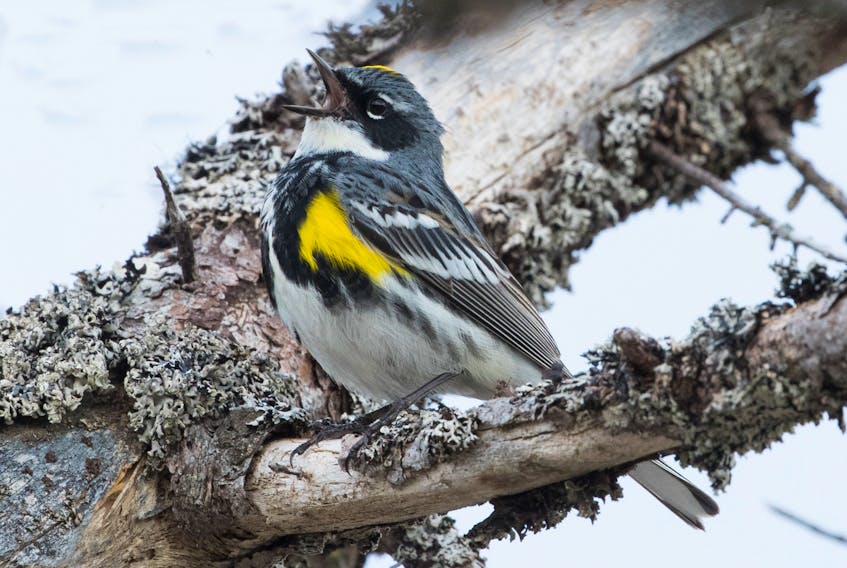It has been a cool month of May. Day after day the temperatures fail to reach the average highs posted on the Environment Canada website for the date.
It is not only Newfoundland and Labrador but all of eastern Canada and the northeast United States that has been suffering through a cold May.
Birdwatchers in all these regions are noting an exceptionally slow pace to bird migration.

Most of the bird species migrating at this time of year are dependent on insect life for food. Insects thrive in the warm weather.
The birds know this and do not want to arrive on their breeding grounds before their food supply is ready.
So it boils down to a matter of survival that tree swallows and most of the warblers have been a full week late in arriving in Newfoundland.
For birders the arrival of the warblers in May is one of the most anticipated events of the year. The warblers are a group of many species each decked out in a unique combination of colours and designs.
There are 18 species of warblers nesting Newfoundland and Labrador. Their slow arrival is like waiting in line to get into a long anticipated music concert.
The line is moving at a painfully sluggish pace this May. It is not only their designer outfits but the warbler songs are a vibrant part of the spring show. The woods have been abnormally quiet on these cool mornings.
During migration there are always a few over-eager birds that bypass their mark and end up farther north than they intended.
Such rare birds add spice to the season. A little blue heron is a southern species that has been entertaining a birders in Bonavista for a few days.
Interestingly there is a great blue heron feeding in the same marsh for direct comparison in the size as well as other markings. Great blue herons nest in small numbers in the southwest corner of Newfoundland but are rare elsewhere in the province.
Feeder watchers sometimes get blessed with a southern overshoot in May.
The rose-breasted grosbeak is a bold black and white bird with a fiery pink breast patch. A few of these have showed up this spring.
The latest recipients of these gems have been Linda Cutler-Kenny of Fermeuse and Jerome Curran in Ferryland.
In the same category was the Baltimore oriole that surprised feeder watcher Michelle Davis in St. Vincent’s. After these overshoots refuel up they should turn around and fly southwest again toward the mainland somewhere.
Some northern wheatear have a unique migration route. Instead of stopping in northern Europe or Iceland like most of their clan, a few migrate on to the eastern Canadian Arctic and northern Labrador to nest.
This is good for us here on the island. Each migration period a few wheatears slip up a little and show up on the east coast of Newfoundland. There have been five reported this spring between the Northern Peninsula and the Avalon Peninsula.
The one enjoyed by the most people was found by Alison Mews at Bear Cove just south of Renews. It spent a full week there running down insects on the thick kelp bed deposited on the beach providing many birders with their best views or even first views of this dapper gray, black and white and bird with a rich buffy coloured breasted.
There is currently an interesting event happening in the waters along the eastern shoreline of the Avalon Peninsula.
There is something small in the water that is attracting large numbers of gulls and phalaropes.
What is a phalarope? They are a swimming member of the shorebird family. They live at sea when they are not nesting in the Arctic.
In fact we landlubbers do not see phalaropes often. But this spring we have been treated to good numbers of the red-necked phalarope at a few locations like Cape St. Francis, Carbonear and Ferryland Head.
The little birds swim in groups rapidly picking at tiny items in the water that we cannot see. Whatever it is they are eating must be present in a great abundance for the gulls to go after it also.
Not all gulls feed with such finesse.
A dark-backed gull with a black head and red bill joined the ring-billed gulls behind the Tim Hortons on Ropewalk Lane in St. John’s begging for handouts of doughnuts and muffins. It is an attractive looking bird from the south called a laughing gull. It is abundant along the east coast of the United States with a few straying as far north as Newfoundland each spring and summer.
Even the non-birders enjoying their coffees while social distancing in their cars were entertained by the close views of this strikingly different looking gull.
Hang on there. Eventually the warmer weather will be here.
It’s a guarantee!
Bruce Mactavish is an environmental consultant and avid birdwatcher. He can be reached at [email protected]









